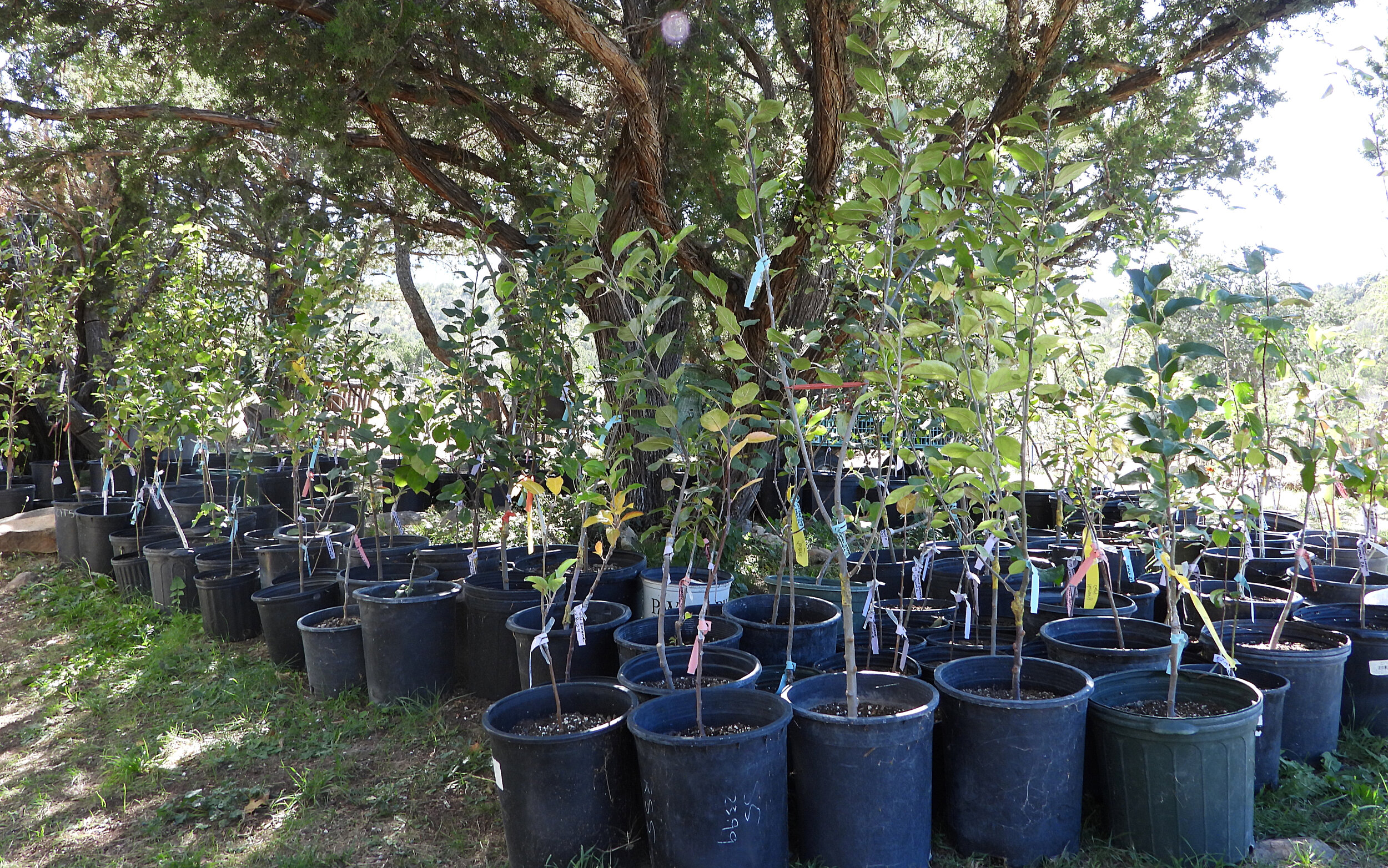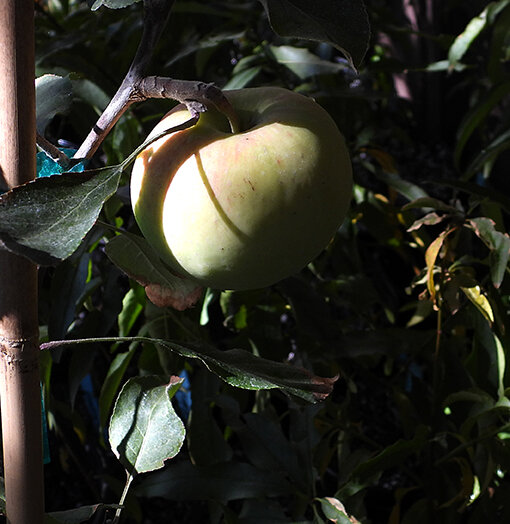Apple trees for sale at Isle of Sky Nursery
Young fruit trees are grown outside in an environment protected from hail and full sun by a native juniper tree which has been carefully pruned to the the job.
Fall apple - October
The first apple on a “sale” tree produced only 18 months after grafting.
Dwarf and heirloom Apple Trees
Jaimee specializes in grafting dwarf and heirloom apple trees many of which she has found growing in old orchards and homestead sites throughout New Mexico.
“The parent trees, many well over a century old, have proven their worth in adaptability and production under harsh conditions. — Jaimee
”
Apple tree size is based on the rootstock
Rootstocks determine the size of the mature tree, NOT the size of the fruit!
Very Dwarfing
EMLA27 — Good for large containers (25 gallon size or larger) or small spaces in ground. Jaimee has good success with the EMLA 27. Trees can be maintained at 4'-6'. Hardy to -25. Trees begin to produce as soon as the next year after grafting. Trees need support (be creative!) for the fruit loads at maturity.
Dwarf size rootstocks are great for small spaces. Grow as a small tree (stake it) or wonderful against a fence or on a trellis. Espalier or grown as a cordon.
Budagovsky 9 or "Bud" 9 — Can be maintained at 6' to 10'. Developed in Soviet Union where temps drop to -55 degrees. Introduces early fruiting characteristics. This is a very reliable and widely used rootstock here in New Mexico.
Pajam 2 — Similar in size to the Bud 9, can be maintained at about 6' to 10'. Jaimee just started using this rootstock at the White Oaks 6,500-foot elevation, and is very impressed with it. This rootstock is known for conferring vigor and productivity, earlier maturity, improved color and size of fruit.
EMLA 26 — Trees can be maintained at 8' to 14' and its Hardy to -40 degrees. Does well on most soils that are well drained. Still requires staking or trellising on windy sites.
Semi-Dwarf rootstocks can be maintained at 18' to 20' tall. They need plenty of room to reach mature, size and you will need to wait 3 to 4 years before they come into production.
MM 111 — This is Jaimee’s "go-to" semi-dwarf rootstock for New Mexico soils and growing conditions. Roots form a fibrous mat and are well-anchored at maturity. It does well in a wide variety of soils and is hardy to -35 degrees.
Remember all trees come with permanent copper tags and a free pack of Jaimee’s “Grow Mix” fertilizer for planting.
varieties of apple Trees for sale may include
Adina — From Austrailia. Low chill requirements so it's a good choice for warmer winter areas. Firm, juicy, sweet red skinned Apple.
Akane — Bred in Japan at the Tohoku AES in 1970, this cross of Jonathan and Worcester Permain is a cold Hardy, self- fertile Apple. Red with hard, crisp, juicy white flesh. Tart, sprightly flavor resembling Jonathan. Winter Hardy but also tends to do well in warmer areas.
Ashmead's Kernel — A very cold hardy English Apple grown from a seed in about 1700 by Dr. Ashmead. Greenish yells with heavy russet. Crisp, juicy flesh, good fresh eating and cooking, very good winter storage, 800-1000 chill hours- ripens late in Fall.
Baldwin — Large, red crisp, juicy eating apple. Good keeper. Seedling originated in Lowell, Massachusetts about 1740.
Blushing Golden — Golden fruit with a beautiful orange red blush. Sweet, crisp, juicy, sprightly flavor which I love. Parents grow in the Kingston, New Mexico orchard where they are heavy and reliable producers. This Apple is self pollinating and a good pollinator for other apples as well. It stores well and doesn't shrivel.
Champagne Reinette — Renowned for flavor, crispy, juicy, beautiful, historic golden Apple. Great pollinator for others, self pollinating.
Crawley Reinette — Late 1800's culinary and cooking Apple. Blooms late and is very cold hardy. Ripens late. Pale yellow flushed with crimson on the sunny side.
Fameuse/Snow — Thought to be a parent of McIntosh. Originated from French Seed (one of the few apples that will reproduce itself from seed) brought to Canada in the late 1600's. Very Hardy, good producer. Medium size fruit, red over cream colored with white flesh. Tender, spicy, aromatic flavor which I like very much to eat fresh.
Fortune — Vigorous, large yellow Apple. Newer variety.
Golden Delicious — From the old Mullins strain, 1912, West Virginia. Believed to be a cross between Grimes Golden and a Golden Reinette. Golden yellow fruit that is firm, crisp, juicy and wonderfully flavorful. Self pollinating and good pollinator for other apples. Very cold Hardy and sets blooms repeatedly over a long period so it is often able to miss late frosts. This Apple was bought by Stark Brothers in 1914. It bruises easily so tends not to be at its best on store shelves. Fresh off the tree, there are few apples this good.
Grapefruit — Self pollinating golden apple from the historic Kingston, NM, orchard.
Greer #2 — Great tasting Apple from the historic Green Berry Greer orchard in Lincoln County, NM.
Greer #3 — A delicious eating apple, red striped over gold, with white flesh. From the large, old Greenberry Greer orchard circa late 1800's, on Bonito creek in Lincoln County, NM. Very cold Hardy.
Greer #8 “Yum!" — Grafted with scion wood from one of the old GreenBerry Greer orchard trees thought to have been planted prior to the 1890's. Linda Fuchs named this Apple (as we have no recorded ID) after eating one off the tree in taste testing trial in the orchard some years ago. Sweet yet has that sprightly tartness and juicy crunch.
Hubbardstons Nonesuch — Massachusetts 1830. Mostly red with golden highlights. hard, crisp fine grained flesh with a sprightly, rich flavor. I really love the flavor. Considered one of the greatest Massachusetts apples of the 19th century.
Lamb Abbey Pearmain — A rare old English variety Introduced in 1804 . Raised from a seed of Newtown Pippin imported from America. Small, red striped fruit. Crisp, juicy, sugary white flesh with very good flavor.
Moses Wood — Originated on the farm of Moses Wood, Winthrop, Maine around 1847. Very Hardy, light yellow Apple with red striping. Fine grained, tender, juicy good for fresh eating or cooking.
Northern Spy — Northern Spy originated in East Bloomfield, New York, prior to 1800. It's a Hardy one. Fruit is greenish yellow some occasional russet. Flesh is firm, crisp, juicy and somewhat tart. It's a good keeper. Nice one for fresh apple pie in February.
Orleans Reinette — Hardy late dessert Apple thought to have originated in France prior to 1776. Firm, fine textured and juicy with lovely flavor. Green-yellow fruit flushed with dull orange.
Ribston Pippin — This is one of the special old ones. A highly prized dessert Apple discovered at Ribston Hall in Yorkshire, England. Thought to have been raised from a seed brought there from Rouen in about 1688. Amazingly, the original tree, blown down in 1810, was supported by stakes and continued to bear fruit until it died in 1835. Yet, from the base, a young shoot grew into a tree which bore fruit until it, too, was blown down in 1928. An unremarkable looking Apple, it is greenish yellow flushed with brown and has often some russet at the base. The hard, crisp, fine grained flesh has a rich, aromatic flavor which Jaimee loves this one for fresh eating and making pies. Also it's well known as a cider Apple. (This is a Tripliod.)
Salazar — From the historic orchard near Lincoln, New Mexico, the ancestor may well have witnessed events of the Lincoln County War. This delicious red striped Apple is crisp, juicy and sweet. Jaimee just loves the flavor. The mother trees have stood the test of time.
Spanish Dessert — Rare, medium sized, red apple from the old orchard in Kingston, NM. Crispy, juicy, wonderful flavored.
Starr — Pretty large Apple with yellow green skin and a nice tasting, tender flesh. The variety is vigorous and ripens fairly early. It's supposed to keep well, but I wouldn't know as I eat them as soon as they ripen. This old timer originated in New Jersey on the farm of John Starr in the late 1700's. Apple that is very Hardy and productive. One of my favorite fresh eating apples!
Yates — Pretty hard to beat this little old timer...
Yellow Horse — Thought to have originated in North Carolina about 1800. Popular in the South until around 1930, a leading variety for drying as it tiled in the heat of summer. Pale yellow Apple with tender yellow flesh great for fresh eating, drying or cider. Fairly cold Hardy, self pollinating.
Yellow Newtown Pippin — This plain looking yellowish green apple originated in Newtown, Long Island, New York, in the early 1700's. It is one of the oldest commercial varieties in America. When fully ripe, the skin is light yellow and the flesh is rich, aromatic and crisp with a refreshing tartness. It is good for fresh eating, baking or processing and excellent for cider. It is a great keeper and Jaimee likes how it develops even more flavor and sweetness in winter storage.
Yellow Pie — This Apple is one of the old survivors in the Kingston, NM orchard. I have never found any Apple description that comes close to this Apple, so far. It ripens in late October. The apples are round and have a beautiful, almost transparent, golden skin. They are tender, sweet yet tangy, juicy and seem to bruise easily. I doubt they keep well. As the name suggests, fresh eating, sauces and pies are its forte.
Wild Earlene — Discovered as a wild seedling near an old homestead near Nogal, New Mexico by Wayne Delaney who was clearing brush down stream from the original, old homestead orchard. He alerted his brother, Dan, who was nearby working and they picked some of the apples from the tree that had obviously been growing there for many years, lost in the willow thicket. It’s likely dropped fruit from the original orchard trees had sprouted in this sheltered thicket, protected from grazing deer and elk. There were a few high up apples that the birds had not yet found and we were able to test them. Jaimee immediately loved the firm, sweet yet tart apples and knew they had found a good one. Over the last few years, the brothers have cleared around the tree and made a well to catch upslope water around it. Jaimee and the brothers pruned and fertilized it as well. The response was amazing and the tree is now vigorous with new growth. “I named this tree “Wild Earlene” after their mother, Earlene Delaney who is an amazing woman and one of my heroes.” — Jaimee

